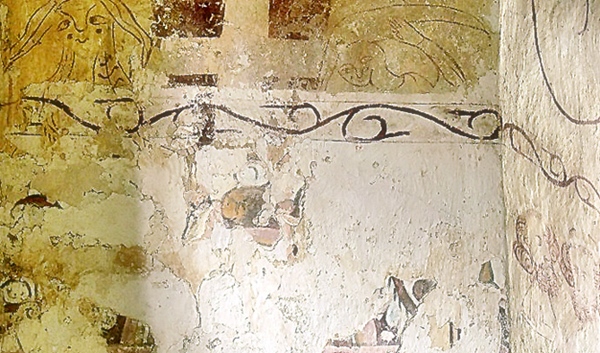Burton Dassett, Warwickshire (†Oxford) c.1250
The Nativity, with two curious Jews

The painting of the Three Magi in the splays of a window in the north chapel at Burton Dassett has been on this site for some years, and it has always been obvious to me that one of them is looking towards something on an adjoining wall in the chapel and discussing it with the other (these two Magi can be seen at the lower far right of this photograph.) Two very curious-looking heads painted in the top tier of the adjoining wall simply made the problem even more intriguing. After much thought and closer inspection I am now sure about what is going on here. The two curious (in all senses) figures at the top of the photograph are Jews, shown stereotypically in an anti-Semitic age, with distorted facial features, cross-eyed, and with what I think are intended to be high-bridged noses. The puzzle about why a painter of such obvious talent should include such grotesquerie is solved if we accept that it is deliberate and intentional. The figure on the right is cautiously lifting a curtain or a hanging to peer beyond it, while the one on the left has strange headgear (possibly a distorted notion of the Jewish phylactery) and odd designs on either side of his neck, about which I cannot hazard a guess.

What these men are looking at is in the centre of the large photograph, just below a band of scrollwork ornament, where the tiny infant Christ lies in a manger, or possibly a crib, and this is also what the two Magi on the right-hand wall in the photograph above are discussing/gesturing towards. The enlarged and annoted detail at the right should help to make this clearer. The whole wall has been overpainted with later texts and elaborate spiral designs some of which have been cleaned or have flaked away in their turn, making the entire area a partial palimpsest, or in more everyday parlance, a glorious mess. But the ‘spying Jews’ interpretation is not fanciful, or fantastical, or wishful thinking, because there is precedent for this elaboration of the Nativity story in English wallpainting. The Flight into Egypt at Coombes in West Sussex is around a century earlier than the Burton Dassett painting and therefore stylistically very different, but the theme of Bethlehem Jews wondering at this thing which had come to pass and trying to find out more is precisely the same, and there is more on this point on the page for the Coombes example.
I have discussed the Burton Dassett heads and their meaning with Dr Anthony Bale, Senior Lecturer at Birkbeck, University of London, who concurs, and adds ‘they [the heads] are grotesque, movingly and haltingly so, and that might be the purpose they serve exegetically …’ To which I would only add that medieval painters were very skilled in the expression of malignity when they needed to show it, but there is nothing malign about the Burton Dassett heads – they are simply wistful, excluded, ultimately pitiable.¹
¹ Between the two Jews, what looks like a Cross may be just that. ‘Elevating’ the Cross and placing it at the top centre of the wall, especially in the context of this subtly realised Nativity, would be very much in line with 13th century icono-theological thinking, but the point is impossible to prove now.